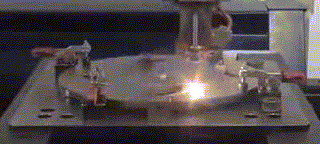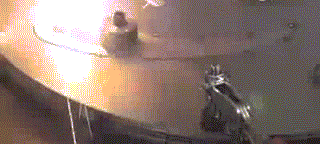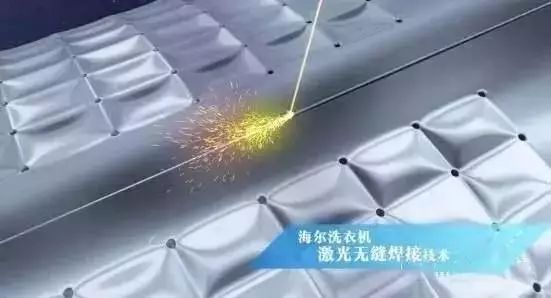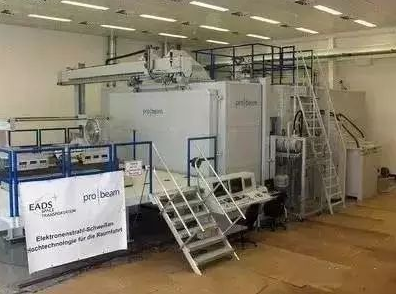1. Laser welding
Laser welding: Laser radiation heats the surface to be processed, and the surface heat diffuses to the inside through heat conduction. By controlling laser parameters such as laser pulse width, energy, peak power and repetition frequency, the workpiece is melted to form a specific molten pool.
▲Spot welding of welded parts
▲Continuous laser welding
Laser welding can be achieved by using continuous or pulsed laser beams. The principles of laser welding can be divided into heat conduction welding and laser deep penetration welding. When the power density is less than 10~10 W/cm, it is heat conduction welding, at which the penetration depth is shallow and the welding speed is slow; when the power density is greater than 10~10 W/cm, the metal surface is concave into a "hole" due to the heat, forming a deep penetration weld, which has the characteristics of fast welding speed and large depth-to-width ratio.
Xinfa welding equipment has the characteristics of high quality and low price. For details, please visit: Welding & Cutting Manufacturers - China Welding & Cutting Factory & Suppliers (xinfatools.com)
Laser welding technology is widely used in high-precision manufacturing fields such as automobiles, ships, aircraft, and high-speed railways. It has brought significant improvements to people's quality of life and led the home appliance industry into the era of precision manufacturing.
Especially after Volkswagen created the 42-meter seamless welding technology, which greatly improved the integrity and stability of the car body, Haier Group, a leading home appliance company, grandly launched the first washing machine produced with laser seamless welding technology. Advanced laser technology can bring great changes to people's lives. 2
2. Laser hybrid welding
Laser hybrid welding is a combination of laser beam welding and MIG welding technology to achieve the best welding effect, fast and weld bridging ability, and is currently the most advanced welding method.
The advantages of laser hybrid welding are: fast speed, small thermal deformation, small heat-affected area, and ensure the metal structure and mechanical properties of the weld.
In addition to the welding of thin-plate structural parts of automobiles, laser hybrid welding is also suitable for many other applications. For example, this technology is applied to the production of concrete pumps and mobile crane booms. These processes require high-strength steel processing. Traditional technologies often increase costs due to the need for other auxiliary processes (such as preheating).
In addition, this technology can also be applied to the manufacture of rail vehicles and conventional steel structures (such as bridges, fuel tanks, etc.).
3. Friction stir welding
Friction stir welding uses friction heat and plastic deformation heat as welding heat sources. The friction stir welding process is that a stirring needle of a cylinder or other shape (such as a threaded cylinder) is inserted into the joint of the workpiece, and the high-speed rotation of the welding head causes it to rub against the welding workpiece material, thereby increasing the temperature of the material at the connection part and softening it.
During the friction stir welding process, the workpiece must be rigidly fixed on the backing pad, and the welding head rotates at high speed while moving relative to the workpiece along the joint of the workpiece.
The protruding section of the welding head extends into the material for friction and stirring, and the shoulder of the welding head generates heat by friction with the surface of the workpiece, and is used to prevent the overflow of the plastic state material, and can also play a role in removing the surface oxide film.
At the end of the friction stir weld, a keyhole is left at the terminal. Usually this keyhole can be cut off or sealed with other welding methods.
Friction stir welding can realize welding between dissimilar materials, such as metals, ceramics, plastics, etc. Friction stir welding has high welding quality, is not easy to produce defects, and is easy to achieve mechanization, automation, stable quality, low cost and high efficiency.
4. Electron beam welding
Electron beam welding is a welding method that uses the heat energy generated by the accelerated and focused electron beam bombarding the weldment placed in a vacuum or non-vacuum.
Electron beam welding is widely used in many industries such as aerospace, atomic energy, national defense and military industry, automobiles, and electrical and electrical instruments because of its advantages of no need for welding rods, not easy to oxidize, good process repeatability, and small thermal deformation.
Working principle of electron beam welding
Electrons escape from the emitter (cathode) in the electron gun. Under the action of the accelerating voltage, the electrons are accelerated to 0.3 to 0.7 times the speed of light, and have a certain kinetic energy. Then, through the action of the electrostatic lens and electromagnetic lens in the electron gun, they are converged into an electron beam with a high success rate density.
This electron beam hits the surface of the workpiece, and the electron kinetic energy is converted into heat energy, causing the metal to melt and evaporate rapidly. Under the action of high-pressure metal vapor, a small hole is quickly "drilled" on the surface of the workpiece, also known as a "keyhole". As the electron beam and the workpiece move relative to each other, the liquid metal flows around the small hole to the back of the molten pool, and cools and solidifies to form a weld.
▲Electron beam welding machine
Main features of electron beam welding
Electron beam has strong penetration ability, extremely high power density, large weld depth-to-width ratio, up to 50:1, can realize one-time forming of thick materials, and the maximum welding thickness reaches 300mm.
Good welding accessibility, fast welding speed, generally above 1m/min, small heat-affected zone, small welding deformation, and high welding structure precision.
Electron beam energy can be adjusted, the thickness of the welded metal can be from as thin as 0.05mm to as thick as 300mm, without beveling, one-time welding forming, which is unattainable by other welding methods.
The range of materials that can be welded by electron beam is relatively large, especially suitable for welding of active metals, refractory metals and workpieces with high quality requirements.
5. Ultrasonic metal welding
Ultrasonic metal welding is a special method of connecting the same or dissimilar metals using the mechanical vibration energy of ultrasonic frequency.
When metal is ultrasonically welded, neither current nor high-temperature heat source is applied to the workpiece. It only converts the vibration energy of the frame into friction work, deformation energy and limited temperature rise in the workpiece under static pressure. The metallurgical bonding between the joints is a solid-state welding achieved without melting the parent material.
It effectively overcomes the spatter and oxidation phenomena produced during resistance welding. The ultrasonic metal welder can perform single-point welding, multi-point welding and short-strip welding on thin wires or thin sheets of non-ferrous metals such as copper, silver, aluminum and nickel. It can be widely used in the welding of thyristor leads, fuse sheets, electrical leads, lithium battery pole pieces and pole ears.
Ultrasonic metal welding uses high-frequency vibration waves to transmit to the metal surface to be welded. Under pressure, the two metal surfaces rub against each other to form a fusion between the molecular layers.
The advantages of ultrasonic metal welding are fast, energy-saving, high fusion strength, good conductivity, no sparks, and close to cold processing; the disadvantages are that the welded metal parts cannot be too thick (generally less than or equal to 5mm), the welding point cannot be too large, and pressure is required.
6. Flash butt welding
The principle of flash butt welding is to use a butt welding machine to make the metal at both ends contact, pass a low-voltage strong current, and after the metal is heated to a certain temperature and softened, axial pressure forging is performed to form a butt welding joint.
Before the two welds are in contact, they are clamped by two clamp electrodes and connected to the power supply. The movable clamp is moved, and the end faces of the two welds are lightly in contact and powered on for heating. The contact point forms liquid metal due to heating and explodes, and the sparks are sprayed to form flashes. The movable clamp is continuously moved, and flashes occur continuously. The two ends of the weld are heated. After reaching a certain temperature, the end faces of the two workpieces are squeezed, the welding power supply is cut off, and they are firmly welded together.
The contact point is flashed by heating the weld joint with resistance, melting the end face metal of the weld, and the top force is quickly applied to complete the welding.
Rebar flash butt welding is a pressure welding method that places two rebars in a butt-jointed form, uses the resistance heat generated by the welding current passing through the contact point of the two rebars to melt the metal at the contact point, produces strong spatter, forms flashes, is accompanied by a pungent odor, releases trace molecules, and quickly applies a top forging force to complete the process.
Post time: Aug-21-2024







